With hundreds of success stories behind it, this step-by-step sourdough starter recipe shows you how to create your own bubbly starter in six days, no fancy tools required. Perfected over years of testing, this easy method is foolproof!
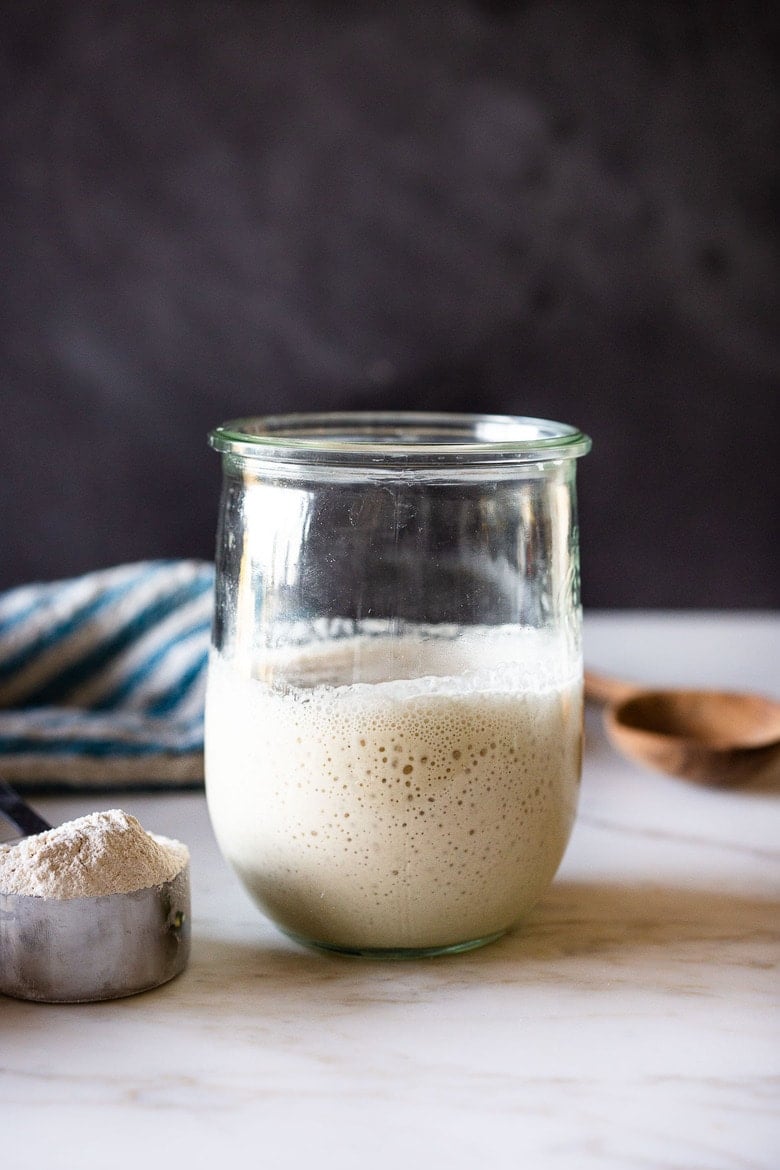
When you understand one thing through and through, you understand everything.
Shunryu Suzuki
With over 500 five-star reviews and hundreds of success stories, my chef's perfected sourdough starter guide has everything you need to make your own homemade starter. It is an easy process, and once you understand it, you’ll think to yourself, Why didn’t I do this sooner! In just six days, you'll be baking the most beautiful sourdough bread! Just read all the success stories below.
What is Sourdough starter?
Sourdough starter is a “wild yeast” made from flour, water, and the natural wild yeast in the air. With a little care and patience, it ferments, and when strong and active, just a little bit of starter replaces commercial yeast and makes your bread rise, while transforming the gluten in the bread into something more easily digestible. Store-bought yeast is not needed!
How long will it take?
It takes 6-7 days to make sourdough starter from scratch. In colder climates, it can take up to 12 days, and in warmer climates, it may only take 5 days. Once you have a bubbling active starter that consistently rises and falls, you can bake sourdough bread, typically on day 7. For a primer, watch the 20-minute Sourdough Video below, where I personally walk you through each day.
Watch: How to Make Sourdough Starter From Bread Flour
Fast forward to Specific Day by video time (using scroll bar underneath video)
- Day 1 Morning: :23
- Day 2 Morning: 4:10
- Day 3 Morning: 7:00
- Day 3 Evening: 9:12
- Day 4 Morning: 11:50
- Day 4 Evening: 13:37
- Day 5 Morning: 14:45
- Day 6 Evening: 16:50
- Day 6 Morning: 18:12
- Day 6 Evening: 20:10
Best Sourdough Starter Ingredients
Sourdough Starter Equipment
- Jar – A wide-mouth quart jar or a Weck’s 1-liter tulip jar.
- Kitchen Scale – using a kitchen scale helps measure the flour and water more accurately – optional but handy.
- Thermometer – Knowing the temperature of the starter using a thermometer gives you great information!
Sourdough Starter Ingredients
- Flour – 5 lb bag of organic bread flour (plus 1-2 cups organic whole grain flour like rye flour or whole wheat flour). All-purpose flour is not reccommended. Whole grain flour has more wild yeast- and will help jump start your starter!
- Water – filtered water, tap water, or mineral water (specifically, San Pellegrino, for the correct mineral ratio). Distilled water does not have enough minerals.
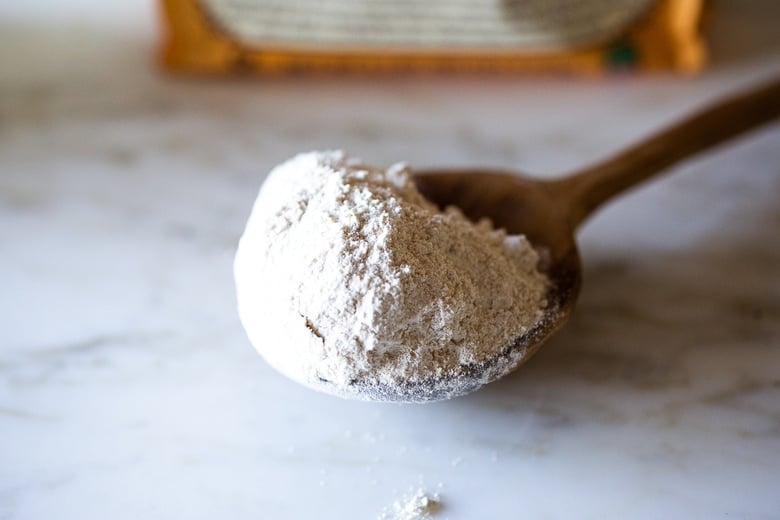
Understanding Your Sourdough Starter
The secret to making sourdough starter is understanding the process, your environment and your starter’s needs. Each starter is different and unique. Here, we’ll show you what to look for and most importantly, why.
- Think of sourdough starter as a yeast. Only in this case, instead of buying a packet of yeast from the store, you are making your own living “wild yeast” by fermenting flour and water. Once it’s bubbly and happy, it is very much like a very low-maintenance pet. Yes, you can even name it. Mine is called Vita.
- You must feed it (stir in a mixture of flour and water) once a week to keep your pet active and strong. We will show you how to tell when it is hungry and when to feed it.
- Some people believe that bread made with sourdough starter is actually better for you than bread made with yeast. Here and here are a few articles to get you started on your own research. While I’m not sure if this is scientifically proven, I do know that bread made with sourdough starter, tastes infinitely better, feels easier to digest, and has more complexity and better texture than bread made with commercial yeast. So if you are a bread lover, this is absolutely the way to go, as far as the quality of your finished bread.
How to Make Sourdough Starter from Bread Flour
*See the recipe card for detailed instructions.
For your first measurement, weigh the flour using a kitchen scale so you can get an idea of how the mixture should feel. Do not weigh the measuring cup! It should be like a thick paste, like peanut butter. If you need to add a little more water to incorporate the flour, that is OK too.
Day 1: Starting in the morning or at night, using a wide-mouth quart jar, tulip jar, mix 1 cup whole grain flour (120 grams) with 1/2 cup filtered water (120 grams) using a fork, making sure you’ve incorporated all the dry flour.
Place the lid lightly on top (using the Weck jar lid is really handy here) or a wet towel to keep moisture in, or plastic wrap- and let sit at room temperature (70-ish degrees) on the kitchen counter for 24-48 hours. If you are unsure how warm it is, use a kitchen thermometer and check it a few hours later. It is best at 70-75°F.
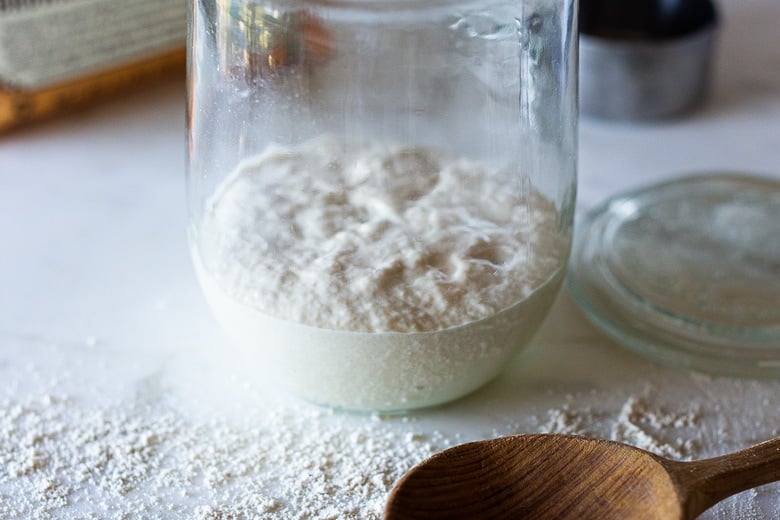
Day 2: After the first 24 hours, there may or may not be a bit of bubbling. Let the mixture rest until you see activity (bubbles or rising). Sometimes this takes 36 hours or even 48 hours, especially if the weather is very cold. When you see active bubbling, discard all but 1/2 cup of the starter (4 ounces).
To the remaining ½ cup of starter, stir in 1/2 cup lukewarm water (120 grams), and mix well with a fork. Add 1 cup of organic bread flour (120 grams) spooned and leveled. Stir until combined. Again, it should feel like a thick paste. If overly dry, feel free to add a bit more water. Cover again and allow the mixture to sit at room temperature for another 24 hours.
Day 3: After 24 hours, hopefully, you will see some bubbling or rising, and if not, let it go longer until you see some activity. Be patient. Depending on how warm your house is and how active your starter, you may need to feed it less often or more often, depending on when it gets “hungry”.
How to Know when to Feed your starter
Only feed your starter after it has peaked or looks “hungry”. Feeding it when it is “not hungry” will basically dilute all the growing yeast and make it lethargic. Better to underfeed than overfeed. How to tell if it is hungry?
- Look for “slide marks” (be sure to use a clean jar so you can see these clearly-see photo below).
- Thin and runny. The starter is liquid enough to pour out of the jar (when at room temperature).
- There is liquid at the top of the starter- a clear sign of hunger!
- Smells like acetone. The starter has processed all of the previous feeding and needs to be fed again.
In the photo below, the starter “peaked” at the top line, then slid down. I call these slide marks- indicating the starter is hungry.

This might be 12 hours, it might be 14, it might be 18, or 24, depending on the temp in your house. In very warm climates, it may only be 6-8 hours. In winter, this may take 36 hours. It is better to underfeed rather than overfeed.
For each feeding, discard all but 1/2 cup of the starter (keeping roughly ½-cup of starter in the jar). Add 1/2 cup water and 1 cup bread flour (spooned and leveled). Mix well, cover, and let this rest at room temperature for 12-24 hours or until the starter looks “hungry” again before repeating.
Day 4: Feed 1-2 times a day (only feeding when hungry), discarding all but 1/2 cup of starter each time. Feed 1 cup of bread flour and 1/2 cup of water.
TIP: It is typical on day 4 for the starter to slow down and stall a bit. This is OK. Just keep going, be patient, and look for the hunger signs, and only feed when clearly hungry. Hopefully, you’ll begin to see some rising and falling. It’s helpful to put the starter in a clean jar each day and mark the beginning level (with a sharpie, string or rubber band) so you can easily see this.
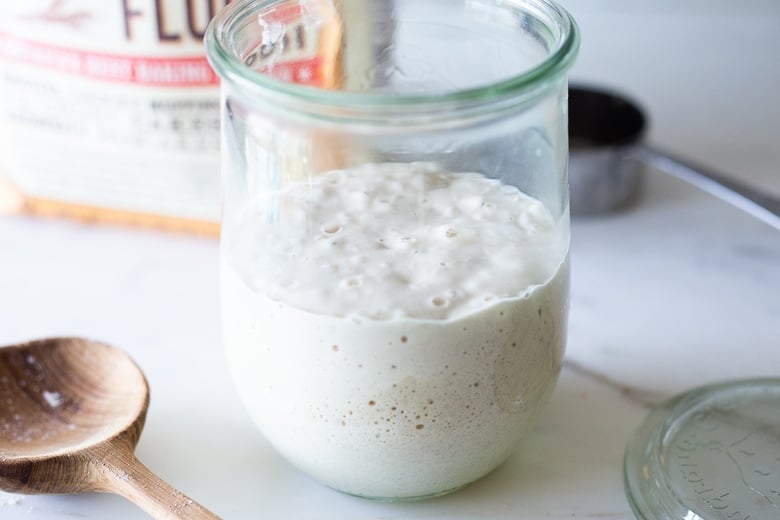
Above, you’ll see it peaking, and below, you’ll see it deflating and getting “hungry.” There may not be too much difference in the beginning, so look closely.
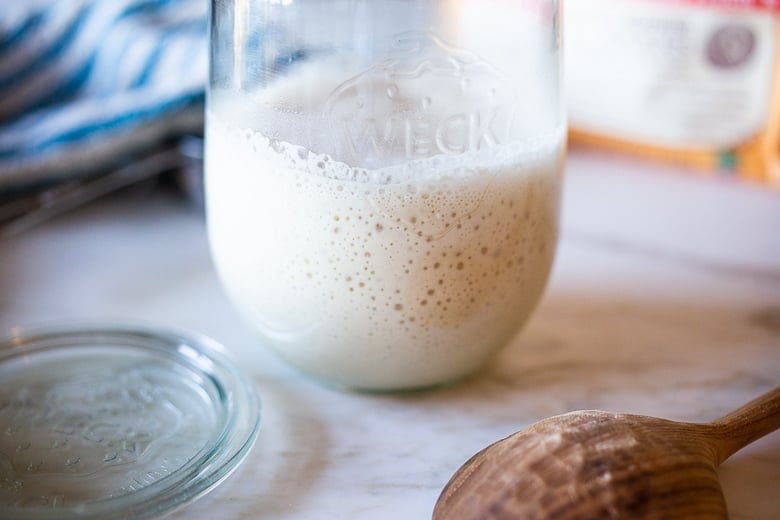
Understand that your starter has a schedule of its own; it is a living thing, so watch it and pay attention.
If your starter is not rising and falling, look at its consistency. As it metabolizes the flour and gets hungry, it will get runny and liquidy, like to the point where you can pour it right out of the jar. If it is still thick like paste, it’s not done metabolizing (eating) the flour.
Day 5: Feed again, 1-2 times, discarding all but a 1/2 cup of the starter each time. Add 1 cup of bread flour and 1/2 cup of lukewarm water. The starter should look visibly active, bubbling, rising, hopefully, close to doubling in size.
*Repeat day 5 until the starter is rising and falling predictably and is close to doubling in size within 6-8 hours.
If your starter is not rising but there is evidence of hunger (runny or liquid at the top), try these three things:
- Substitute 1/4 cup whole grain flour (add to ¾ cup white bread flour) on your next feeding.
- Use mineral water like San Pellegrino instead of water.
- Stir the starter a few times after feeding to allow more wild yeast from the kitchen to get inside.
DAY 6 Morning: Baking day! Give it one last feeding in the morning: this time discard all but a 1/3 cup. (The reason we are changing this to 1/3 cup is to feed it a little bit more.) Add 1 cup flour (120 grams) and 1/2 cup water, stir, and place it in a clean jar so you can see the activity clearly. You can use a Sharpie or place a rubber band around the jar to mark the beginning level.
How to Know When Your Bread Flour Sourdough Starter is Ready to Bake Bread
The starter should double in volume within 6-8 hours of feeding.
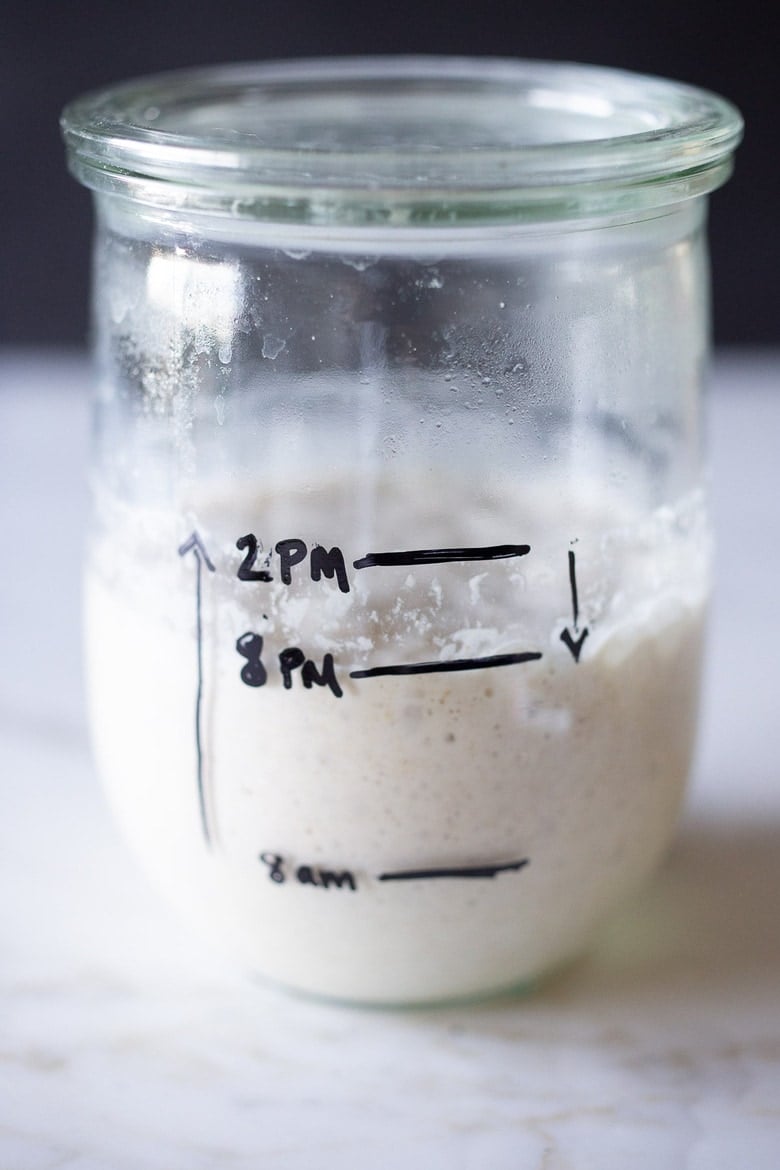
In the photo above, on the 6th day, the starter was fed at 8 am, it peaked around 2 pm, then it started deflating, and by 8 pm, it was “hungry” again. See those downward “slide” marks on the jar?
Do the Float Test
When the starter is at its peak, or just after, place a teaspoon of starter (just from the top, don’t stir it down) in a glass full of water; it should hopefully float. If it floats, success! Congrats. You can now make our sourdough bread…tonight!
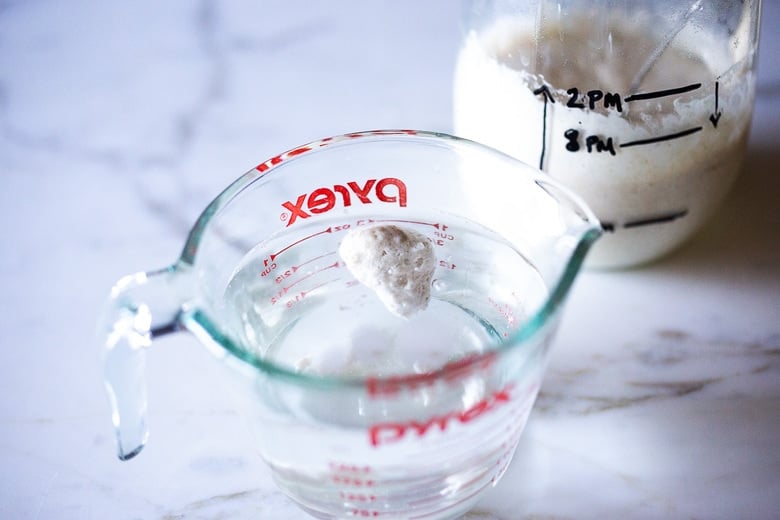
My Best Sourdough Baking Tip. When baking bread, always use a hungry starter that has already peaked.
STARTER DOES NOT FLOAT? If it doubles in size but does not float, you can still try baking a loaf if it doubles within 6-8 hours of feeding it.
At this point, if your starter does not double in size within 6-8 hours of feeding, don’t give up! Often, it just takes longer, especially during the winter months. Continue feeding one to two times a day until you see a consistent, predictable rise and fall.
Read the troubleshooting section. If you need to take a break, put it in the fridge and try it again up to a week later. Don’t toss it!
Day 6 Evening: Let’s Bake! Use 1/3 cup starter to make this sourdough bread recipe and place the remaining starter (or if not making bread, place all of it) in the refrigerator, and feed it at least once a week, reserving ½ cup starter, before feeding it the usual 1 cup bread flour, 1/2 cup water.
TROUBLESHOOTING the Best Sourdough Starter
- SMELL: Starter should smell sweet, tangy, earthy, like a wet horse – not “bad”. If it really smells foul or unpleasant, you may have used an unclean jar, an unclean utensil, or somehow introduced other bad bacteria. I would start over.
- NO ACTION: On day 4-5 it is typically for it to slow down. If your starter is not rising at all but there is evidence of hunger (liquid at the top, or bubbles) try 3 things. First substitute 1/4 cup whole grain flour (add to ¾ cup white bread flour) on your next feeding. If no rise, then try using mineral water, specifically San Pellegrino instead of water. San Pelligrino specifically has the right mineral ratio, I have great luck with it. Others not so much! Also try stirring the starter a couple of hours after feeding, a couple of times throughout the day to allow wild yeast from the room to get in there. Lastly, you could try pineapple juice instead of water.
- FLOUR: Try to use fresh milled whole grain flour to start, then organic BREAD FLOUR. The more wild yeast in the flour, the better your starter will do, so smaller brands like Bob’s Red Mill seem to do better than bigger conventional brands that have been overly processed. It is totally OK to mix flours and to switch them up- this adds different kinds of wild yeast- a good thing!
- DO NOT overfeed. For example, maybe feeding 2 x day at 12-hour intervals is too often. You want to feed after the starter has peaked, then deflated (see photo above- you’ll see some slide marks on the jar) and this tells you that it is hungry. If you feed the starter before it has had a chance to metabolize (or eat) all the flour (before peaking) and then you discard part of it, and feed it again, you are actually diluting all that amazing bacteria, weakening your starter. So it’s all about watching your starter in your home. If you are not seeing rising and falling, but notice the starter just gets liquidy, this too is a sign of “hunger”. Or if it gets runny enough to pour out of the jar, another sign it is hungry. There are lots of variables here. Just be patient, pay attention and watch. This is a living thing- it doesn’t care about time schedules and recipes or what it “should” do. It will “eat” when it is “hungry” and sometimes it likes to eat slowly. 😉
- TIME: It may take longer than 6 days in colder environments. Use a kitchen thermometer and take its temp. Is it over 65F? Find a place where it can be warm. In the oven with the light on, or in an upper cupboard (heat rises). Sometimes it takes 12-14 days! Be patient, keep going. If it is doing absolutely nothing, leave it out on the counter for 24-48 hours and see what happens. If you run out of flour or need a break, don’t just toss it; put it in the fridge and see if you can get it going a few days later.
- ACIDITY: If you still can’t get that starter going, some people recommend subbing pineapple juice for the water for one feeding- raising the acidity level. My good friend just tried this and it got hers going.
- LIQUID: If you see any liquid at the top of your starter, it means your starter is hungry. So, yes it’s still alive which is a good thing! You can stir the liquid in, or pour the liquid out, either way, but feed it. This is a sign that you may need to feed it more often.
- MOLD: if you see any discoloring or mold on the surface, starter was probably contaminated. If it is only on the surface, it is probably ok to save. Scrape it off, save 1/2 cup of the underneath starter, and keep going, using a clean jar. Feed, smell, use your best judgment.
- FLOAT TEST: Try testing when your starter is peaking. Take a spoonful from the top without stirring it down. If your starter is rising and falling consistently, but not passing the float test and it has been over 8-10 days, just try baking a loaf. People are having luck with good loaves without passing the float test. It may be the flour…
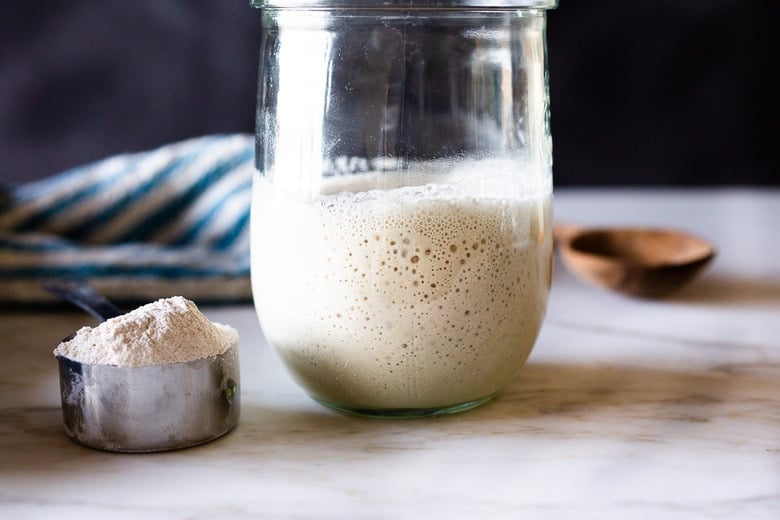
Sourdough Starter with Bread Flour Storage Tips
- REFRIGERATE & FEED AT LEAST ONCE A WEEK: Pick a scheduled day and try to stick with it, always reserving 1/2 cup and feeding it 1 cup flour and 1/2 cup water. Discard the remaining, give it away, or keep the discard in a separate container for sourdough pancakes, sourdough buns, banana bread, biscuits, etc. I usually don’t feed the discard unless I give it away.
- If you forget to feed it one week, it is most likely OK; feed it 1-2 times a day for 1-3 days in a row to revive it (keeping it out on the counter) until bubbly and active and doubles within 6 hours. I’ve left my starter for a month on vacation (in the fridge) without feeding and simply revived it by feeding it 3 days in a row, 1-2 x day. It’s surprisingly hard to kill. You can also freeze it for more extended storage.
- This batch of starter will allow you to bake 2 loaves of bread per week with enough left to feed for the next week. If you want to bake more often, you can keep it out and feed it 1-2 x daily. Or if baking every few days, you can pull it out of the fridge, feed it 10 hours before using, leaving it out, use what you need while it is peaking (or slightly after), then put it back in the fridge that evening. Do the same thing a few days later when ready to use again. So this would be feeding 2-3 times a week, best if baking 4-5 times a week.
- If you are not actively baking, you can maintain a smaller amount of starter using the same ratios.
- You can also freeze the sourdough starter if you’re leaving on a long trip.
FAQs for this Sourdough Starter Recipe with Bread Flour
Yes. While you are building your starter, during the first week, it is the simplest, easiest, fastest, and most economical way to create a healthy starter. (Or save it separately -in the fridge- and use it in Pancakes, Waffles, Buns, or Biscuits. ) This is because you always have to feed it two times its volume in flour. For example-if you kept all the 1 1/2 cups of starter, you would have to feed it 3 cups of flour (instead of keeping just a 1/2 cup and only feeding it ONE cup). Discarding will shorten the fermentation process, require less flour in the long run, and create a stronger starter. Once your starter is “established” after the first week- then you can give it away to friends or use it in pizza dough, pancakes, etc).
This recipe for Sourdough Starter takes 6 days (or up to 12 days if it is very cold where you live).
The only ingredients you need to get started are flour (bread flour and whole grain flour) and water.
What is the biggest mistake you can make with your sourdough starter?
The most common mistake is overfeeding, which weakens your starter instead of making it stronger. The secret is to watch for signs of hunger-bubbles slowing down, slide marks in the jar, or liquid on top-before feeding. Once you learn to read your starter's natural rhythm, it will stay bubbly, active, and ready to bake with.
It's surprisingly simple to make a sourdough starter! The process is hands-off and only takes a few minutes each day. The key is consistency: feed it regularly and keep it at a steady temperature. Once you get into the rhythm, caring for your starter becomes second nature, and you'll be rewarded with a healthy, bubbly culture for all your baking.
How to use Beginner Sourdough Starter
- See all our Sourdough Recipes!
- Sourdough Scones
- Sourdough Crackers
- Sourdough Biscuits
- Sourdough English Muffins
- Sourdough Tortillas!
- Vegan Banana Bread
- Overnight Sourdough Waffles
More from Feasting At Home
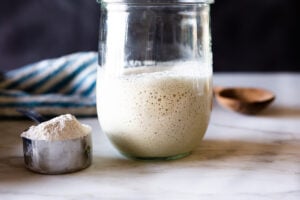
Sourdough Starter Recipe with Bread Flour
- Prep Time: 30
- Cook Time: 6 days
- Total Time: 144 hours 30 minutes
- Yield: 1 ½ cups 1x
- Category: sourdough, fermented, cultured, bread, baking,
- Method: fermented
- Cuisine: bread
- Diet: Vegan
Description
How to make your own Sourdough Starter (see the step-by-step video in post) using simple ingredients with no special equipment, in 6 days, that can be used in sourdough bread. Sourdough Starter is a wild yeast, made from fermenting flour and water.
Ingredients
- 120 grams whole grain flour (whole wheat flour, rye flour, or freshly milled flour) 1 cup, fluffed, spooned and leveled
- Organic White Bread Flour (5-10 lb bag ) I like Shepherd’s Grain or Bob’s Red Mill.
- 120 grams Water per feeding (1/2 cup water)
Instructions
-
- Day 1: Starting in the morning or at night, using a wide-mouth quart jar or Crock or Glass Measuring Cup mix 1 cup whole grain flour (120 grams) with 1/2 cup (120 grams) filtered water using a fork making sure you’ve incorporated all the dry flour. For your first measuring – it is a good idea to weigh the flour, using a kitchen scale so you get an idea of how thick it should feel. It should be like a thick paste. Thick like peanut butter. If you need to add a little more water to incorporate the flour, that is OK, but be precise with the flour. Place the lid on top (using the Weck jar is really handy here) or a damp towel to keep moisture in, or plastic wrap- and let sit at room temperature (70-80 degrees) on the kitchen counter for 24-48 hours, or until you see some bubbling. If you are not sure how warm it is, use a kitchen thermometer and check it a few hours later. See notes for TEMPERATURE.
- Day 2: After the first 24 hours, you may or may not see a bit of bubbling. I prefer to let this rest until I see a tiny bit of activity (bubbles) and sometimes this takes 36 or up to 48 hours. So start “day 2”, when you see a little bit of bubbing. Discard all but 1/2 cup (136 grams) of the starter. (See notes for discard). Add to the remainder, 1 cup of white bread flour, (120 grams), spooned and leveled, and 1/2 cup filtered water (120 grams), mixing well with a fork. Place the lid on loosely again and allow the mixture to sit at room temperature (70-80F) for another 24 hours.
- Day 3: By the third day, you should definitely see some bubbling- and if not, let it go a bit longer. Depending on how warm your house is and how active your starter, you may need to begin feeding more often, or even move to two feedings a day roughly 12 hours apart, like in the morning and at night. In a nutshell, you want to feed the starter only after it has peaked (metabolized all the flour from the last feeding) and has started sinking down or gets liquidy- this is when it is hungry! This might be 12 hours, it might be 14, it might be 18, or 24, depending on the temp in your house. In very warm climates it may only be 8 hours. It is better to underfeed rather than overfeed here. For each feeding, like before, discard all but 1/2 cup of the STARTER (keeping roughly ½-cup of starter in the jar -4 ounces or 136 grams) Add 1 cup Bread Flour (spooned and leveled) and 1/2 cup water to the 1/2 cup starter and let this rest at room temperature for 12-24 hours or until the starter looks “hungry” again before repeating.
- Day 4: Feed 1-2 times, discarding all but 1/2 cup of starter EACH TIME. Feed 1 cup bread flour, 1/2 cup water. Look for the hunger signs. Hopefully, you’ll begin to see some rising and falling. It’s helpful to put the starter in a clean jar and mark the beginning level (with sharpie, string or rubber band) so you can easily see this. ***If for some reason your starter looks like it is still rising at the time of second feeding (at night) and there is no evidence it has fallen or no slide marks, it is still “eating” so skip this feeding and feed first thing in the morning. AGAIN, Feeding it when it is “not hungry” will basically dilute all the growing yeast and make it lethargic. Better to starve than overfeed.
- Day 5: Feed again, 1-2 times, roughly 12 hours apart, or when hungry, discarding all but a 1/2 cup the starter EACH TIME. 1 cup bread flour, 1/2 cup lukewarm water. The starter should look active, bubbling, rising, sliding down, hopefully, close to doubling in size. (If not, repeat this day until starter doubles in size within 8-12 hours of feeding- and read the troubleshooting section.)
- DAY 6: Give it one last feeding. Discard all but a 1/3 cup. Add 1 cup flour ( 120 grams) and 1/2 cup water, and place it in a clean jar so you can see the action clearly. You can use a sharpie or place a rubber band around the jar to mark the beginning level. The starter should hopefully double in volume within 6 hours of feeding. When it peaks, DO THE FLOAT TEST: To test the starter, place a teaspoon of starter (just from the top, while it is peaking, don’t stir it down) in a glass full of water, it should hopefully float. If it does, you can make sourdough bread. Tonight! Let the starter keep resting at room temperature or a few more hours allowing it to fully metabolize the flour, perhaps sinking a little before making your dough. You want to make dough with slightly hungry starter. Place the remaining starter in the fridge and feed it in a week. You’ll have enough stater to make one more sourdough loaf during the week, and still have enough to feed. If you want to wait to make bread until later in the week place starter in the fridge. Be sure to feed it in 7 days. Read maintenance section.
- At this point, if your starter does not double in size don’t give up! Often it just takes longer, sometimes up to two weeks, especially if it’s cold. Continue feeding one-two times a day (only when hungry) for a few more days, until you see a visible rise and fall. Read the troubleshooting section. If you need to take a break, just put it in the fridge and try it again up to a week later. Don’t toss it- if there are bubbles, it is still alive.
- This batch of starter will make two loaves of bread with enough left over to feed for the following week.
Notes
- TEMPERATURE: The colder your home, the longer it will take for the starter to grow and become active (bubbles). Find a warm spot (70-80 degrees) for the best results. On the stovetop, with the light turned on, or on top of the fridge. Or in the oven with the light on. On top of a heating pad (set to low) with a towel in between). You can still make the starter in a colder home, it will just take longer- even up to 2 weeks.
- FLOUR: Always try to start the batch by using organic, freshly milled whole-grain flour (wheat or rye) because it has more wild yeast in it than All-Purpose or white flour and will get it active and growing sooner. You can, of course, continue to use whole grain, but I’ve had the best luck using organic “bread” flour for days 2 through 6. People have made a sourdough starter with All-Purpose flour- but personally, this has never worked for me– there are fewer nutrients and wild yeasts in the flour and results in a very lethargic starter. If it is your only option, try mixing in 2+ tablespoons of whole-grain (wheat or rye) with the AP flour per feeding. Feel free to use different flours or mix different flours together. It is OK to use all-purpose flour if in a pinch, but using it repeatedly will result in sad starter.
- WATER: I usually use tap water -but sometimes the chlorine in tap water can inhibit the growth of your starter. Lukewarm water helps fermentation to start faster. Sterilized bottled water is often overly sterile, and can also inhibit. Mineral water, like Perrier (carbonated is OK) can sometimes work miracles.
- HYDRATION: Hydration refers to the ratio of water to flour in terms of weight. It is a ratio. The starter is typically at 100% hydration- meaning equal parts flour and water, in terms of weight. So if you use 120 grams of water, use 120 grams of flour. This roughly translates to 1 cup of flour and 1/2 cup water. Feel free to weigh instead of measure if you want to be more precise, or want to familiarize yourself with the consistency you are aiming for. If using whole grain flours (which tend to be “thirstier”) and your starter seems very thick, it is totally OK to add more water to thin it a bit. I intentionally keep the hydration a little lower here (a thicker starter) so you can more clearly see the rise and fall “action” in the jar.
- STORING AND FEEDING: When your starter is kept cold, in the fridge, you don’t need to feed it as often- only once a week. Feel free to feed it “cold”, and put it right back in the fridge if you like. If you keep it out on the counter, you’ll likely need to feed it 1-2 x daily (or just watch and feed only when hungry). Cold slows down the fermentation, heat speeds it up.
- USING: When you need to use your starter for baking bread, feed it 10-12 hours before making bread dough, using it after its peak height. For a more “sour” flavored bread, use the starter straight from the fridge, 3-6 days after feeding. The starter gets more sour tasting the longer it goes without feeding. Feeding the starter the same day as making bread will produce a milder sourdough flavor.
Nutrition
- Serving Size: 1 tablespoon
- Calories: 31
- Sugar: 0 g
- Sodium: 0.2 mg
- Fat: 0.1 g
- Saturated Fat: 0 g
- Trans Fat:
- Carbohydrates: 6.2 g
- Fiber: 0.2 g
- Protein: 1 g
- Cholesterol: 0 mg
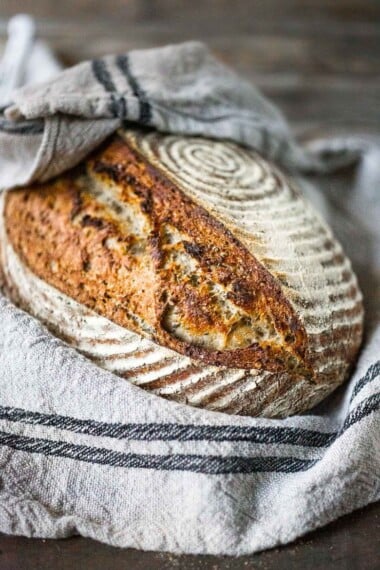

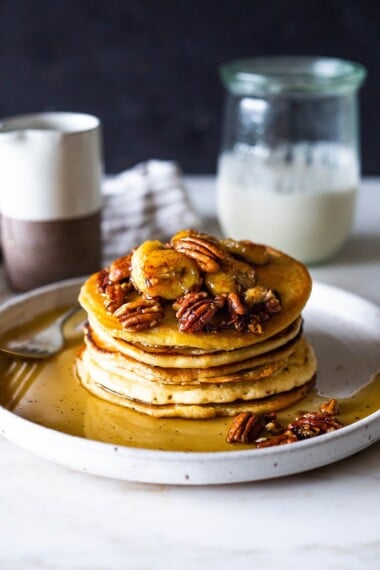
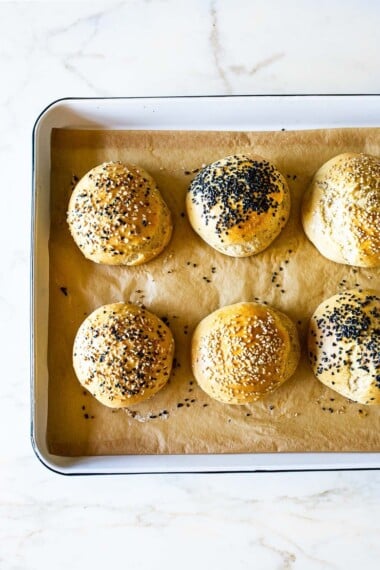





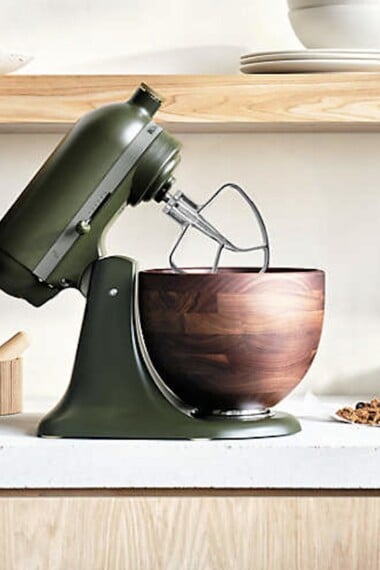


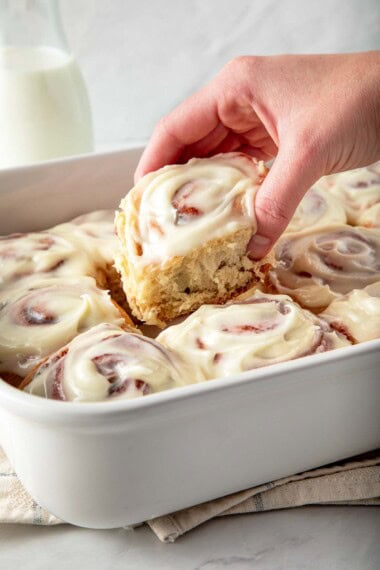

My first day lasted for 1 1/2 days because my house is cooler. I moved the starter to the oven with the light on. It bubbled beautifully. Now on day 2, it grew to more than doubled. If it starts to go down before 24 hours are up, can I feed it the second time? In your recipe, it says to feed it once on day 2. I’m really hoping this starter would work. I’ve tried a few times before. Nothing has ever worked. Your video made it seem so doable. Thank you.
Hi Leandra, yes, I would stick to the once-a-day for the first few days. It is OK if it gets extra “hungry”. You could also try pulling it out of the oven for half the day, to slow it down a bit.
Hi Sylvia, I had to restart my sourdough starter as I accidentally “cooked” my first one when I left it in the oven to keep warm but turned on the oven to pre-heat. Oops. On my second try, it had beautiful activity for the first 3-4 days, and it even rose quite a bit on day 3. But after that it didn’t rise anymore. I started with whole wheat flour and feed it with bread flour. Sometimes I will also mix in some wholewheat flour. Now I see some bubbling activity but not as much as the first few days. It doesn’t really rise at all but I see some bubbling on the top and there is usually a liquidy layer also. It does look quite liquidy and almost runny. Does that mean I should feed it more often, or feed it less often. I’ve been feeding it about every 24 hours. Do you have any advice to get this going? I fed for 6 days, put it in the fridge for a week when we went out of town for a week, then started feeding it again every 24 hours. Thank you!
I think you are on the right track Cindy. Sometimes it just takes a while. It tends to settle down on day 4 but should get active again, with patience. Keep doing what you are doing- feed when loose/runny/liquidy. Mix in a little whole grain. It may take another week!
Thank you, Sylvia! You are so right! After about 2 weeks, the starter is starting to become more active! I’m on day 3 in week 3 and it’s been rising consistently and has lots of tiny bubbles. It’s not quite doubling yet so I’m hoping by the end of this week it will be ready! 🙂
Yay! Great to hear!
Thank you, Sylvia! You are so right! The starter is finally becoming more active after about 2 weeks. I’m on day 3 of week 3 and it’s been rising consistently for a few days and has lots of tiny bubbles. It’s not quite doubling in size yet, but I’m hoping it will be ready soon! 🙂
Great to hear Cindy!
Hi Sylvia, I thought this past weekend my starter would be ready for making bread. But when I did the last feeding with 1/3 cup starter, the starter was not very active after that feeding, and it didn’t pass the float test. So I kept going. The last couple of days it’s been rising beautifully but not doubling. I did the float test yesterday and it floated! Do you think it’s OK to try baking bread even if the starter isn’t doubling in size? It’s definitely getting foamy and getting good rise. I am finding that I get the best results when I mix AP and bread flour.
Also, can you share an example of a schedule once the starter is established and kept in the fridge? You mentioned that this starter recipe can make 2 loaves of bread each week. Do you typically make bread the day you feed the starter? Do you feed the starter again after you take what you need for baking before putting back in fridge? Would you bake 2 loaves at the same time? What if I only bake 1 loaf a week, do I still feed once a week and I would just have extra discard? Sorry for all the questions!
Feel free to give it a try Cindy! Just make sure to feed the starter once a week no matter how many loaves ( 0-1 or 2) you bake. Sometimes I make it with fed starter, sometimes I just use it straight from the fridge without feeding. If you bake once a week, then yes, you would still need to feed once a week and you would have to discard some ( or use discard in something else like pancakes).
Hi
I read comments where you can use starter after it’s been fed and placed in the fridge for a few days. I’ve tried that so many times and each time my sourdough has gone horribly wrong. It often looks like it’s overproofed. Why’s that?
I’m not sure Kelly. Do you think your starter has peaked (in the fridge) before you use it? You want to be sure to use starter that has peaked or is hungry.
I wish i could share with you the loaf i made using this starter! Absolutely phenomenal .. made the best loaf yet!
Thanks Kelly! Glad it is working for you!
Thank you for the recipe and video.
Do you have suggestions on feeding if you’re going to be out of town for a couple of weeks? Do you just start over?
Angela-it should be fine for a few weeks, just feed it right before you go, and feed it a few times to get it nice and active again before baking with it.
Hi! I’m on day 2 of this, and my starter is going crazy! It has more than quadrupled in size 6 hours after doing the day 2 feeding. Is this normal?
Not normal but AMAZING!
So strange! After the third feeding, it didn’t rise at all :(. Will feed it with half rye flour today
It’s pretty common Bryan- just wait to feed until it is very hungry. 😉
We heat our house to about 60, so in the winter it usually ranges from 53 to 60. In the summer, we cool it to about 66, so it ranges between around 64 and 70. Do you think it is possible to make starter in these circumstances?
Also, is there any reason not to take the extra on feeding day and toss the flour/water/yeast mix that one is not saving to refeed into a batch of pancakes or waffles? It seems silly to toss it when all it is is flour and water, so surely I could make biscuits or something out of it?
Yes, it is possible, but the whole process may take double the time. Feel free to use discard in pancakes and waffles. 🙂
Hello I’m on my fourth day of the starter, i used wheat flour to start and I use half wheat flour and half regular flour with water and I store it in the oven with the light on and I don’t think it’s warm enough. At this point the starter is flat no bubbles, do I throw it out and start agin? And where can I store it that’s warm enough cause my house is cold. I’m frustrated I have been doing this for weeks, I keep starting over again trying to figure out a warm place to store it, I even have one in a box with a heating pad and that’s not working cause the heating pad turns off every two hours, that’s not practical. Any information will help. Thank you
Hi Clarita- can you take the temperautre of the starter when it it in the oven with the light on? just curious.
Dear Sylvia, first of all a huge thank you from my heart to yours for this amazing step-by-step sourdough starter recipe.
I apologize the bother with a question now though.. my starter was incredibly active the first two days. It doubled in size and I was very happy and confident. Since then, it slowed down its activity. I am on day ~6 and I have been feeding only once a day, because it didn’t show much activity. Now, the only heating source in my house is a wood burning stove. That I fire up in the morning and at day time it’s somewhat warm, and the starter is right next to it. At night as the fire goes out, the temperatures drop drastically and the starter is let cold.
I feed the starter in the afternoons when it had the day of warmth and it starts getting thinner. I also see a few bubbles in the dough and a few on top. It smells sour too. It just never increases its size and never rises anymore. I’ve been mixing organic all purpose and organic whole wheat flour.
Would you say it is pointless trying the starter if it’s so cold in the house for at least half a day? Or do you think the signs my starter gives are still enough and it is indeed active?
Will I keep feeding it once a day? I am afraid that is never rises ..
Thank you!
Steffi
It sounds like it is still alive, but just hibernating! So not pointless. Do you have an oven? you could try leaving it in the oven with the light on? Or do you have a heating pad? Just be sure to not overheat it. It is possible too, that being next to the stove could be too hot- have you tried taking its temp, next to the stove?
I thought I did not liek sourdough bread as it was sour. HOwever, I recently had an amazing bread that was sourdough and not sour at all, after research I read there are things you can do to ensure you do not get that sour flavor. Can you please elaborate from your experience what you need to do differently? Thanks kindly! 🙂
Hi Shirley, for the least sour bread, make the dough just after feeding your starter, but wait until after it has risen/peaked. So if you feed your starter at noon, and it peaks at 6 pm, make the dough at 8 pm. 🙂
Thanks kindly! 🙂
Thank you for the recipe! I had great success up until day 6. I discarded all but ⅓ c and followed the recipe for day 6. When I went to use it the next day it didn’t pass the tests so then I discarded all but ⅓ c again and fed it the normal amount. Now it’s bubbling but not rising. Should I have kept all but ½ c and not the ⅓ c since I wasn’t going to use it to bake? How do I recover it?
Hi Melanie- I would let it get ferociously hungry. Save 1/2 cup. Feed, subbing a few tablespoons whole grain and see what happens. 😉
THANK YOU for this amazing post! I started my first ever sourdough starter with a different recipe post and it just wouldn’t get active. Luckily, I found your post! Thanks to your detailed instructions I could save my sourdough starter, it was bubbling in no time even with the very cold temperatures in our house. It got so active I had to feed it several times a day and it kept going all over the place. Now I have a huge jar of a super happy starter!
So happy for you Bianca! Sounds very healthy! Congrats!
I’m so excited about this! Thing is, it’s just me. Would this work the same if I cut everything in half to make just one loaf per week?
Hi Lori- You may not have enough to feed- but you can try it?
I doubled the recipe and made two loaves.
The first one I did plain.
I added herbs, garlic granules and chopped sun-dried tomatoes to the second with grated light cheddar cheese on top.
Both were excellent and didn’t last long ! thank you.
I did however find the ‘cup’ measures confusing in the starter instructions . . . .
Glad this worked for you Joy!
Hello, is it okay to just use king Aurthur’s bread flour through out this process? The ingredients are whole wheat and malted barley flour. A little confused because the ingredients includes whole wheat like this recipe asked for yet the All Purpose flour is the same kind of flour but less protein. I’m considering buying rye flour and substituting that at some point on day 3 or 4. Hope this makes sense. Thanks in advance!
Hi Gia- yes, it makes sense, and I’d just give it a go with the flour you have. If your starter gets inactive, then consider adding some of the rye!
Hi I’m a first time baker. I only have All purpose flour. Can I use this to start my process? Will it work for me if all stars are aligned?.thank you. Derek Watson.
Hi Derek, I personally have never had good luck with all-purpose flour. But feel free to try? Don’t feed it until you see some bubbling action. 🙂
Hi! Thank you for sharing this process. I’m excited to try my hand at my first sourdough starter! I started day 1 today. And my starter looks very thick, not as liquidy as how it looks in your video. Hopefully it turns out OK. Also, will it be OK to use regular bread flour instead of organic bread flour?
Thank you!
Yes, Cindy regular bread flour should be fine. You can add a little more water if need be to loosen if it is hard to mix. 🙂
Thank you, Sylvia! I waited 48 hours and I didn’t really see any bubbling activity. I went ahead and did the first feeding anyway. I started with unbleached organic whole wheat flour. Hopefully I’ll begin to see some activity tomorrow. Fingers crossed!
Keep us posted Cindy. Do not feed again until you see some action. 😉
I’m on day 4 now! It took 48 hours from day 1 to day 2, then another 48 hours to day 3. But I began to see bubbling activity and on day 3 the starter definitely had some rising. It didn’t need more than one feeding on day 3, but we will see how hungry it is for day 4. :). What a fun little project!
Oh good! Glad you are enjoying the process Cindy. It does take longer in winter. 😉
Hi! Sorry for another message. My starter was doing well for a couple of days with rising/peaking. But I guess the last few days have been colder and it’s not been rising. It does get liquidy and I do see bubbles on top. I read in your notes that that also means it’s hungry? If it’s just getting liquidy like that, should I be feeding every 12 hours?
Hi Cindy, yes liquidy means it is hungry. If you see water on the top, it is time to feed – or if it pours out of the jar easily, feed. 🙂
I love the way you offer direct instructions, to the point of discouraging using it too soon. That was beneficial to me. Thanks for an excellent recipe and all problems solving suggestions. This is the best.
Thanks Alice- glad it worked for you!
For the life of me, I cannot find organic bread flour in a local store or on Amazon.ca. Is all-purpose the way to go? Wondering if any Canadians have specific brands they like?
Can you find any locally milled flour?
I don’t know how I missed this comment; my apologies for the delay in responding.
I live in a small province so I don’t believe there is any here.
That being said, I did find some on Amazon so I have ordered that and will go it from there.
Perfect Rayna!
Dear Sylvia,
I HAD an amazing starter for about a year when I accidently threw out the “baby with the bath water” when baking bread! I have been struggling for 10 days trying to get another one started, wondering what I was doing wrong. Finally I put the container with a cup of boiling water in a closed microwave and this morning I had bubbles! I am so happy that I persevered and followed your advice to not overfeed and be patient! I was beginning to feel that your amazing sourdough bread was not to be had again! Phew
Congrats Dori! The BEST feeling. Bubbles in all forms, starter included, are quite magic. 😉
Hi
The past few times my dough ended up with a weird dense texture with really big holes. Does that mean it’s over or underproofed? Also, I fed my starter two days ago which I put straight back in the fridge and now there’s a lot of black hooch on top. Does that mean it needs to be fed again? How do I make it less active? As i only need to bake once every two weeks!! Thanks amazing starter and sourdough recipe!!
Hi Kelly, the hootch indicates it is hungry- yes, time to feed. 2 Days? That seems pretty fast. What flour are you using to feed? What is your fridge temp? Just curious. 😉 Just guessing here, but the bread sounds over-proofed to me.
I’m wondering why we have discard all but 1/2 cup while feeding. Can’t we do something with that instead of throwing it away?
I don’t want it to go to waste. This organic flour is expensive haha.
Hi! After your starter is up and going you can use it in discard or sourdough recipes. But if you use it during the first week it may not have enough strength to “rise” things. You could use it for what it is… just flour and water. Hopefully, that makes sense Melissa!
Day 2 took 36 hrs to see growth before 1st feeding. Ended up being quite liquidy by Day 3. I fed and see zero growth on day 4 even though I added rye flour with bread flour. Also, how do we know when to feed twice/day?
Hi Lisa-always looks for the signs of hunger. Liquidy means it is hungry. It may not ever get to twice a day, especially when the weather cools.
Hi Sylvia, if I’m planning to bake more than one loaf in a day, would there be a problem planning for this by doubling the starter that goes in the fridge, as long as the jar is large enough? I suspect the answer is yes as long as the proportions are the same, but I thought I would ask. I was planning to make both biscuits and a loaf today but discovered to my horror that I only have enough hungry starter to make one or the other, if I want some fed starter to go back in the fridge. 🙂 Thank you again for this great resource and for being so responsive to questions!
Hi and Yes Joe, you can absolutely increase the starter, or you can keep it out of the fridge so it gets hungry sooner, feed-in the morning, should be ready in the evening. Hopefully, that makes sense. 😉
Thank you so much for sharing this recipe and the detailed notes. I live in a cooler climate and it took just under 2 weeks for my starter to “float”. I ended up doing 1/4 rye flour and 3/4 white flour as it didn’t activate very well for me on just all purpose flour (I know you said to use organic bread flour but I didn’t have any in the pantry!). When I switched to this ratio it started working really well for me and with the weather warming up I also started to see faster action.
Now I can’t wait to use it!
Do you have a recipe to use the starter discard in muffins or loaf?
Gald this worked for you! And yes, Lucy, a bunch of recipes are linked at the bottom of the recipe post. The sourdough bread is a great place to start.;)